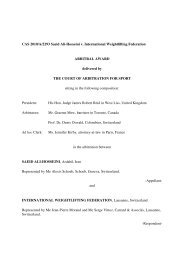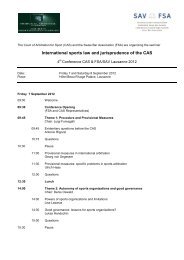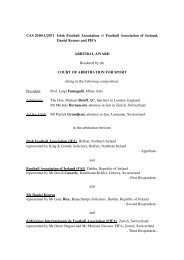(CAS) Bulletin - Tribunal Arbitral du Sport / TAS
(CAS) Bulletin - Tribunal Arbitral du Sport / TAS
(CAS) Bulletin - Tribunal Arbitral du Sport / TAS
Create successful ePaper yourself
Turn your PDF publications into a flip-book with our unique Google optimized e-Paper software.
Although the issue of the use of DEHP-free bags<br />
as an explanation for the differences in the values<br />
of plasticisers in the 20 and 21 July 2011 tests was<br />
not specifi cally dealt with in the second written<br />
submission of WADA, in light of the evidence<br />
ad<strong>du</strong>ced at the hearing, mainly via the answers of Mr<br />
Scott and the article referred to in Dr Geyer’s expert<br />
opinion, the Panel cannot rule out the possibility<br />
that the blood transfusion theory is possible despite<br />
the fact that a phthalate peak was only recorded in<br />
the sample provided by the athlete on 20 July 2010.<br />
Indeed, if Mr Contador had a blood transfusion on 20<br />
July 2010 (which caused the presence of plasticisers)<br />
and a plasma transfusion on 21 July 2010 in order<br />
to dilute the blood (which caused the presence of<br />
clenbuterol, but not the presence of plasticisers), the<br />
absence of a spike in the level of plasticisers could be<br />
explained if the plasma was stored in a DEHP-free<br />
bag.<br />
5.3.3 The Pharmacological and Toxicological<br />
possibility<br />
According to Mr Contador, in constructing the blood<br />
transfusion theory, the Appellants failed to consider<br />
1) how much clenbuterol the donor, whose plasma<br />
the Athlete is alleged to have transfused, would need<br />
to have had in his system in order for his plasma to<br />
contain a suffi cient concentration of clenbuterol to<br />
pro<strong>du</strong>ce a 50 pg/mL reading in the person infusing<br />
that plasma; and 2) the toxicological effect that such<br />
amount would have had on the donor.<br />
The Athlete’s pharmacologist, Dr Tomás Martín-<br />
Jiménez, evaluated the plausibility of the blood<br />
transfusion theory proposed by the Appellants from<br />
a pharmacological and toxicological perspective. Dr<br />
Tomás Martín-Jiménez concludes that: “a typical course<br />
of clenbuterol doping treatment would not pro<strong>du</strong>ce suffi cient<br />
concentration of the drug in the plasma of the donor to pro<strong>du</strong>ce<br />
a dose in 250 mL of plasma that would account for the 50<br />
pg/mL observed in the urine of Alberto Contador. The dose<br />
necessary to achieve that mark would need to be much larger<br />
and in fact would be toxic to the donor, even considering the<br />
pharmacokinetic model most favourable to Dr Ashenden’s<br />
theory. In fact, the results of the clenbuterol excretion study<br />
performed in Cologne indicate that the donor of the plasma<br />
would have needed to receive a highly toxic dose of the drug in<br />
order to pro<strong>du</strong>ce a concentration in plasma that would result<br />
in the 50 pg/mL in the urine of the Athlete following infusion<br />
of the donor’s plasma. […] Based on the results of this study,<br />
we consider that the scenario presented by Dr Ashenden in his<br />
plasma infusion theory is impossible as a cause of the traces of<br />
clenbuterol found in the urine of Alberto Contador <strong>du</strong>ring the<br />
2010 Tour de France”.<br />
Dr Martín-Jiménez’ opinion is supported by Dr<br />
Vivian James who concludes that “it is my opinion that<br />
it would not have been possible for clenbuterol to have been<br />
present in a plasma sample in a suffi cient amount to pro<strong>du</strong>ce<br />
the positive urine result that was found. It is unlikely that any<br />
human donor could have tolerated the amount of clenbuterol<br />
required to achieve the plasma concentration necessary to result<br />
in a urinary concentration of 50 pg/mL following transfusion<br />
of that plasma”.<br />
In its second submission, WADA presented an expert<br />
report by Dr Olivier Rabin. This report was reviewed<br />
by Boehringer Ingelheim in order to establish whether<br />
Dr Rabin’s report was compatible with a study<br />
made by Boehringer Ingelheim where clenbuterol<br />
was administered as an intravenous infusion to six<br />
subjects. Boehringer Ingelheim concluded that the<br />
calculations contained in the report of Dr Rabin<br />
“are compatible with the scientifi c information published on<br />
clenbuterol’s pharmacokinetics by our company as well as with<br />
the unpublished data generated by our company as a developer<br />
and manufacturer of this substance ”.<br />
According to Dr Rabin, an important difference<br />
between his study and the study of Prof. Martín-<br />
Jiménez is that the latter’s study was based on oral<br />
administration of clenbuterol and not on intravenous<br />
administration. The calculations of the report by<br />
Dr Rabin demonstrate that the level of clenbuterol<br />
detected in the Athlete’s Sample of 21 July 2010 is<br />
compatible with not just one, but “several alternative<br />
scenarios of clenbuterol dosing, blood withdrawal and<br />
subsequent reinfusion of plasma”. In particular, Dr Rabin<br />
considered it perfectly possible that a plasma donor<br />
could follow and tolerate a doping regime leading<br />
to the concentration of clenbuterol found in Mr<br />
Contador’s Sample.<br />
This report, nevertheless, also applies the<br />
pharmacokinetic model used to simulate the oral<br />
administration of clenbuterol to the intravenous<br />
administration data for comparison purposes.<br />
Even this analysis, when applying the incorrect<br />
pharmacokinetic model (as done by Dr Martín-<br />
Jiménez in his report), demonstrates that a transfusion<br />
of contaminated plasma could perfectly feasibly<br />
have caused the clenbuterol levels detected in Mr<br />
Contador’s urine.<br />
According to Dr Rabin it is important to establish<br />
when the suspicious plasma transfusion took place<br />
since the blood test performed in the morning of 21<br />
July 2010 detected low levels of clenbuterol in plasma<br />
(~1 ug/mL), whereas the urine test performed in<br />
the evening of that same day yielded 50 pg/mL of<br />
clenbuterol. In principle, such a plasma transfusion<br />
could have taken place at any time between the<br />
Jurisprudence majeure / Leading cases<br />
-<br />
133





